Crème brûlée and custard are two desserts that are often mentioned together, yet they’re distinct in texture, preparation, and presentation. So, what’s the difference between crème brûlée and custard? While both share a creamy base made from eggs, cream, and sugar, crème brûlée stands out with its signature caramelized sugar topping.
Understanding the difference between crème brûlée and custard will help you choose the perfect dessert for your next gathering or experiment with new recipes like What is the Secret of Crème Brûlée? or Crab Brulee Recipe. Let’s dive into what makes each dessert unique and irresistible.
What is Custard?
Custard is a versatile and beloved dessert that serves as the base for many sweet creations. At its core, custard is a mixture of milk or cream, egg yolks, and sugar that is gently cooked until thickened. Its creamy texture and mild sweetness make it incredibly adaptable.
Types of Custard
Custard comes in various forms, depending on how it’s prepared:
- Pourable Custard (Crème Anglaise): A thinner consistency often used as a sauce for desserts like cakes or pies.
- Set Custard: Thicker and firmer, commonly found in pies like Classic Southern Sweet Potato Pie.
- Baked Custard: Used in standalone desserts or as a base for dishes like flans and tarts.
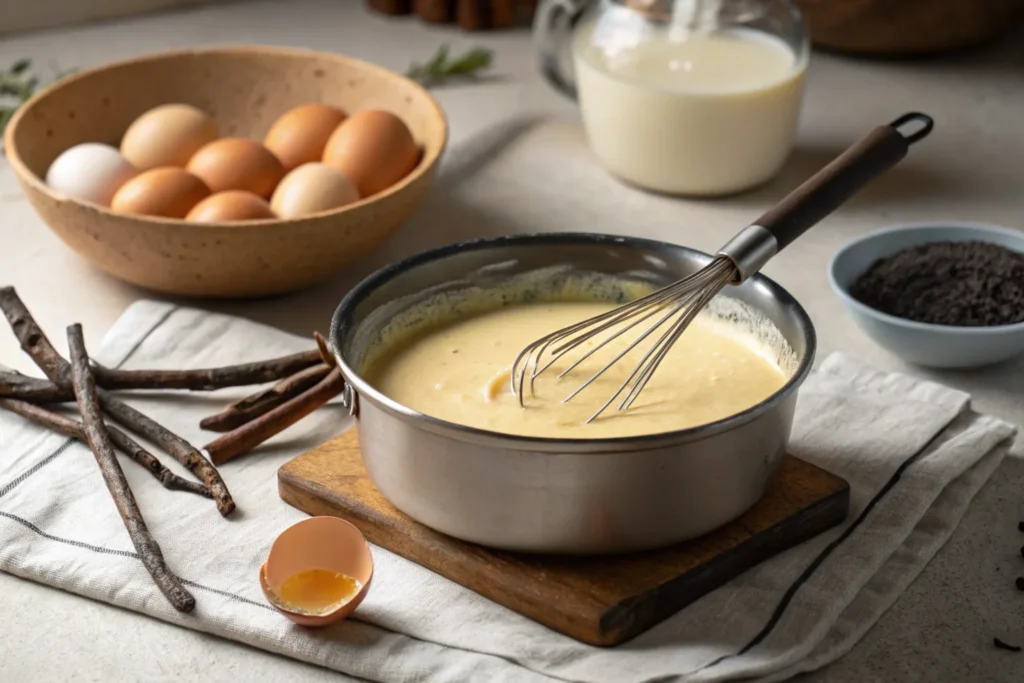
Common Uses for Custard
- As a filling for pastries like éclairs or cream puffs.
- Poured over desserts like sponge cakes or fruit pies.
- As the main feature in desserts like custard tarts or bread pudding.
Custard’s simplicity and versatility make it a staple in kitchens worldwide, offering endless possibilities for creativity.
What is Crème Brûlée?
Crème brûlée is a refined dessert that takes custard to an entirely new level of elegance. French for “burnt cream,” it features a creamy, baked custard base topped with a crisp, caramelized sugar crust. This dessert is known for its satisfying contrast of textures—the smooth custard and the crackly sugar topping that you break with a spoon.
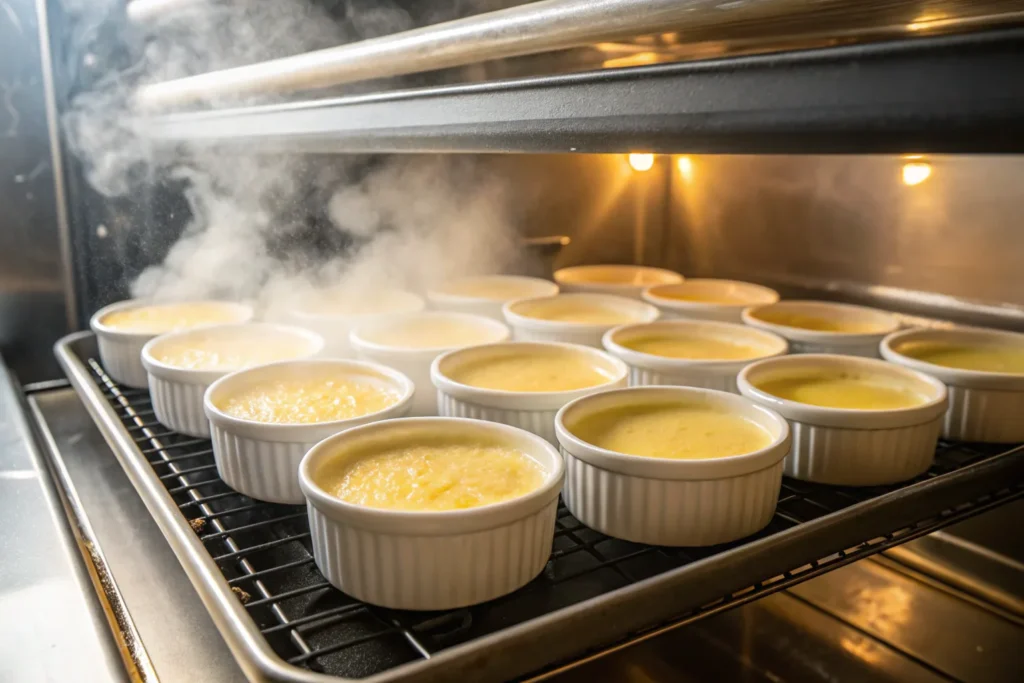
The Key Features of Crème Brûlée
- Creamy Custard Base: Made from heavy cream, egg yolks, sugar, and vanilla, the custard is baked gently in a water bath for an ultra-smooth texture.
- Caramelized Sugar Topping: The thin sugar layer is torched or broiled until golden and crisp, adding a unique flavor and crunchy texture.
- Elegant Presentation: Typically served in individual ramekins, crème brûlée is a sophisticated choice for dinner parties or special occasions.
Where It Shines
Crème brûlée is ideal for those looking for a luxurious dessert experience. It’s a step up from everyday sweets and pairs beautifully with fresh berries or a light dessert wine.
This dessert’s allure lies in its balance of simplicity and sophistication, making it a must-try for anyone exploring custard-based desserts. For similar creations, check out this Crab Brulee Recipe.
The Key Differences Between Crème Brûlée and Custard
If you’ve ever wondered, what’s the difference between crème brûlée and custard, it comes down to texture, preparation, and presentation. Crème brûlée is baked in ramekins and features a crunchy caramelized sugar topping. Meanwhile, custard offers versatility, from pourable sauces to firm pastry creams, making it adaptable for various desserts. Here’s a closer look at what sets them apart:
1. Texture and Consistency
- Crème Brûlée:
The custard base in crème brûlée is firm yet creamy, achieved by baking it in a water bath. Its texture is rich and luxurious, making it feel like a dessert reserved for special occasions. - Custard:
Custard has more variation in texture. It can be thick and firm for pies (like in Classic Southern Sweet Potato Pie) or soft and pourable, such as crème anglaise, used as a dessert sauce.
2. Cooking Methods
- Crème Brûlée:
Always baked in individual ramekins, crème brûlée requires a water bath to ensure even cooking and a silky texture. Once baked, it’s chilled, then topped with sugar that’s caramelized using a torch or broiler. - Custard:
Custard can be cooked on the stovetop, baked, or steamed. It’s often stirred constantly to prevent curdling and is more forgiving in terms of preparation methods.
3. Topping and Presentation
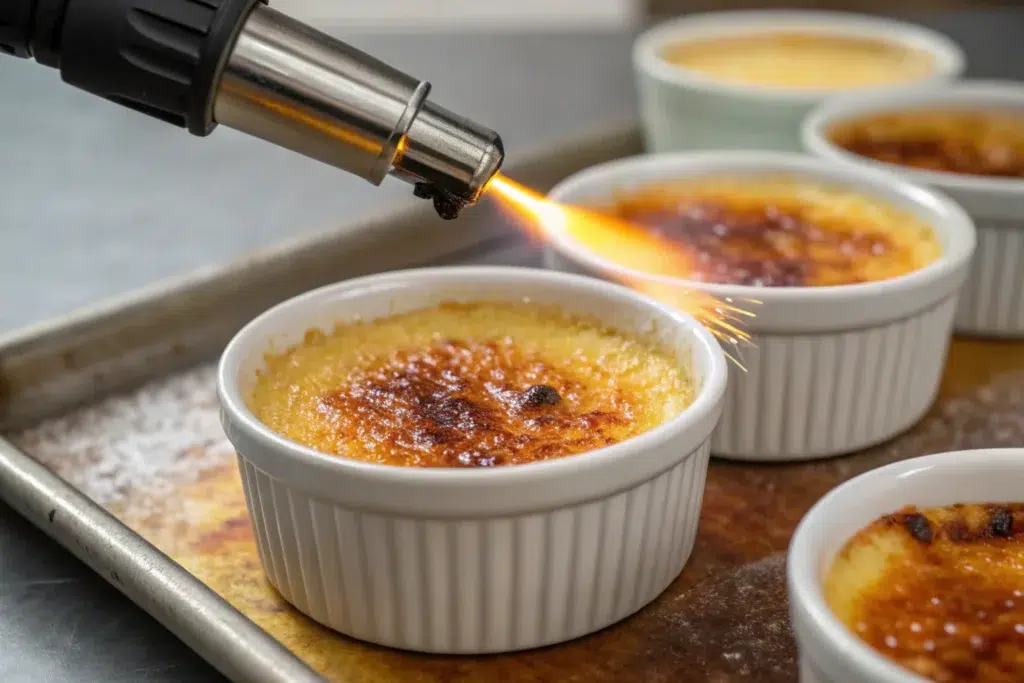
- Crème Brûlée:
Its standout feature is the caramelized sugar topping, which adds a sweet, crunchy layer to the dessert. This makes crème brûlée visually distinct and interactive, as you crack the sugar crust before eating. - Custard:
Typically served plain or with simple garnishes like whipped cream, fruit, or a sprinkle of spices, custard focuses on its creamy consistency rather than additional textures.
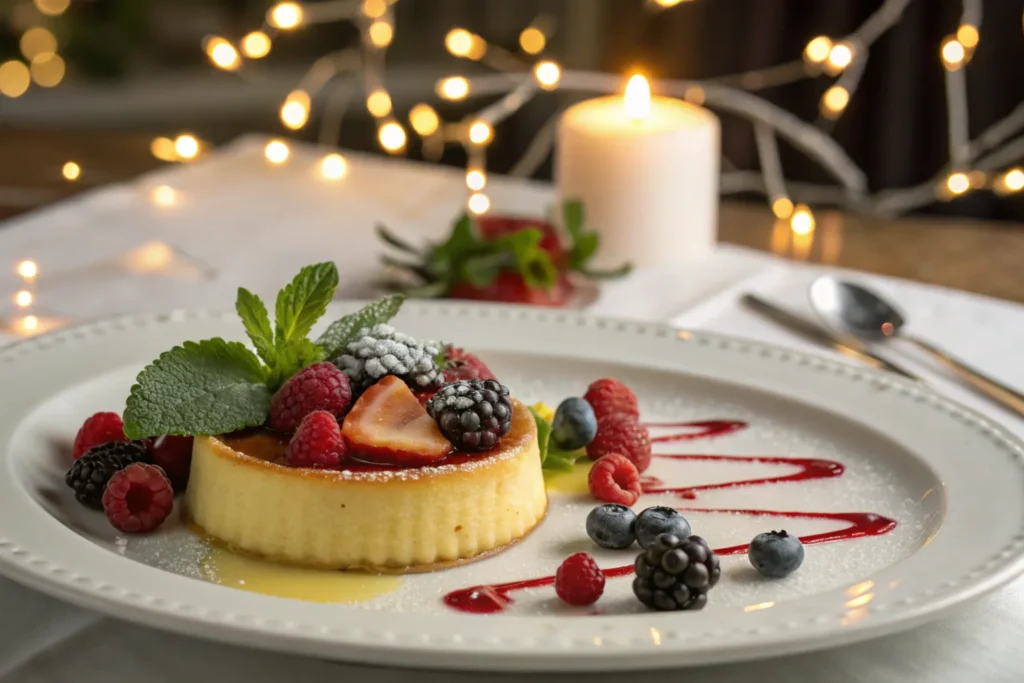
Pro Tip:
If you want the elegance of crème brûlée but prefer the versatility of custard, try experimenting with custard pies or baked custard tarts. For example, Homemade Sweet Potato Pies offer a firmer custard with unique flavors.
Which One Should You Choose?
When deciding what’s the difference between crème brûlée and custard in terms of versatility and elegance, it’s clear each serves a unique purpose. Crème brûlée dazzles with its refined presentation, while custard excels as a base for countless dessert creations. Here’s a quick guide to help you decide:
Choose Crème Brûlée If:
- You Want a Showstopper: Crème brûlée is an elegant dessert that never fails to impress. Its caramelized sugar topping adds a theatrical touch, perfect for dinner parties or romantic evenings.
- You Love a Crunchy Contrast: The crispy sugar crust provides a satisfying texture contrast to the creamy custard below.
- You’re Ready to Experiment: Crème brûlée requires a bit more technique, such as using a kitchen torch or broiler, but mastering it is incredibly rewarding.
Choose Custard If:
- You Want Versatility: Custard can be adapted for a variety of desserts, from pies like Sweet Potato Pie vs. Pumpkin Pie to creamy sauces for cakes.
- You Prefer Simplicity: Making stovetop custard requires less equipment and time, making it ideal for quick dessert cravings.
- You’re Feeding a Crowd: Custard pies or tarts are easy to prepare in larger quantities and serve as a centerpiece dessert.
A Dessert Lover’s Dilemma
Ultimately, the choice between crème brûlée and custard comes down to the experience you want. Crème brûlée feels luxurious and indulgent, while custard offers comforting familiarity and versatility. Why not try both and decide which one wins your heart?
Tips for Making Crème Brûlée and Custard at Home
Whether you’re preparing an elegant crème brûlée or a versatile custard, a few tips can make all the difference. Here’s how to achieve dessert perfection:
1. Start with Fresh Ingredients
- Use high-quality cream, fresh eggs, and pure vanilla for the best flavor.
- Avoid using low-fat substitutes, as they can compromise the texture and richness.
2. Master Temperature Control
- For crème brûlée, bake the custard in a water bath to ensure even cooking and avoid curdling.
- When making stovetop custard, cook on low heat and stir constantly to prevent lumps.
3. Strain for Smoothness
- Always strain the custard mixture through a fine mesh sieve to remove any bits of cooked egg or bubbles. This step guarantees a silky texture.
4. Chill Before Serving
- Both crème brûlée and custard benefit from adequate chilling. Crème brûlée should chill for at least 4 hours to allow the flavors to develop.
- Custard-based pies, like Homemade Sweet Potato Pies, also need time to set before slicing.
5. Perfect the Crème Brûlée Topping
- Sprinkle a thin, even layer of sugar over the custard.
- Use a kitchen torch for precise caramelization, moving it in circular motions for an even crust. If using a broiler, watch carefully to avoid burning.
6. Experiment with Flavors
- Infuse the cream with spices like cinnamon or nutmeg for custard.
- Try adding a splash of liqueur to crème brûlée for a unique twist.
7. Practice Makes Perfect
- Don’t be discouraged if your first attempt isn’t perfect. Both desserts require a bit of practice, but the results are worth it!
With these tips, you’ll be able to master both crème brûlée and custard, impressing your friends and family with your dessert-making skills.
FAQs: What’s the Difference Between Crème Brûlée and Custard?
Yes, crème brûlée tastes like custard, as it is essentially a type of baked custard. However, the caramelized sugar topping adds a distinctive crunch and a hint of sweetness, making it slightly different in taste and texture.
Baked custard refers to any custard cooked in the oven, often without additional toppings. Crème brûlée, on the other hand, is a specific type of baked custard that features a caramelized sugar crust, adding texture and visual appeal.
The three main types of custard are:
Stirred Custard: Cooked on the stovetop and stirred continuously, like crème anglaise.
Baked Custard: Cooked in the oven, such as crème brûlée or custard pies.
Set Custard: Thickened with starch, used for pastry creams or pudding.
Crème brûlée is typically served cold with a freshly caramelized sugar topping that may still be slightly warm. This contrast enhances its appeal.
The French term “crème brûlée” translates to “burnt cream,” referring to the caramelized sugar topping. Its fancy name reflects its elegant origins and presentation.
No, crème brûlée is not just pudding. Both desserts are creamy, but cornstarch thickens pudding, while crème brûlée uses egg yolks to create its custard base and features a signature caramelized sugar topping.
Conclusion
Crème brûlée and custard are both beloved desserts that share a rich, creamy base, but their differences make each unique. Crème brûlée stands out with its caramelized sugar topping and elegant presentation, making it a showstopper for special occasions. Custard, on the other hand, offers versatility, lending itself to everything from pies to creamy sauces.
By understanding what’s the difference between crème brûlée and custard and mastering the techniques for both, you can elevate your dessert repertoire. Whether you’re serving a Classic Southern Sweet Potato Pie or experimenting with a Crab Brulee Recipe, the principles of custard remain essential.
So, why choose between them? Try making both to discover which one satisfies your sweet tooth the most. And remember, the joy of dessert lies in the experience of creating and savoring something truly delicious!

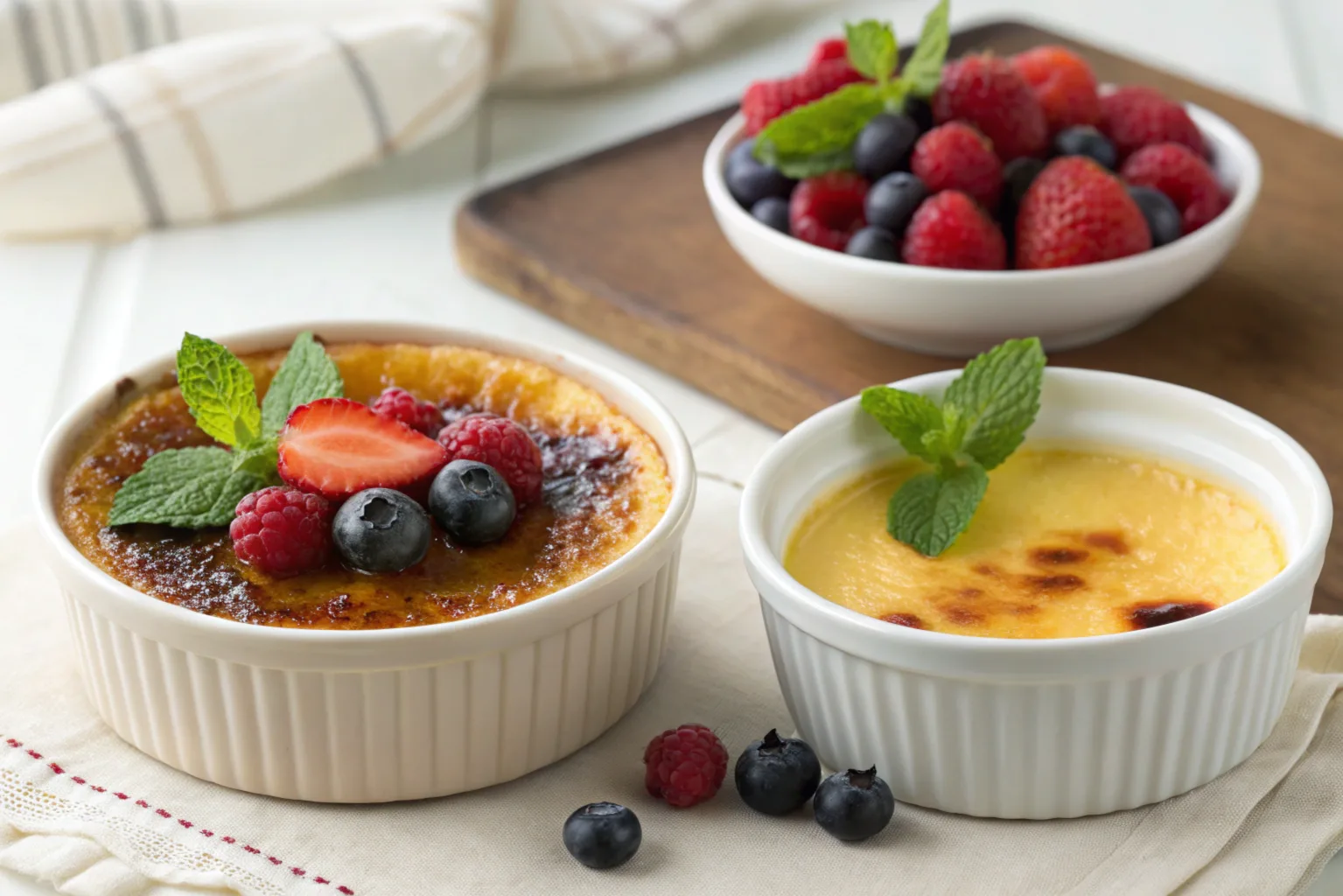
6 thoughts on “What’s the Difference Between Crème Brûlée and Custard? Learn the Key Distinctions”
Comments are closed.